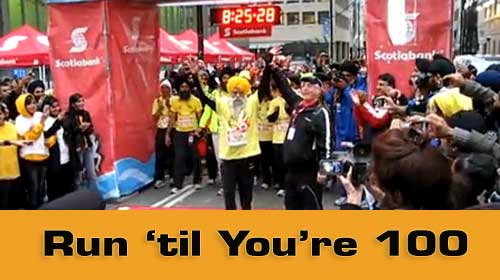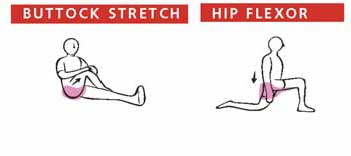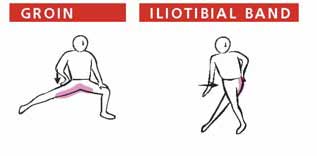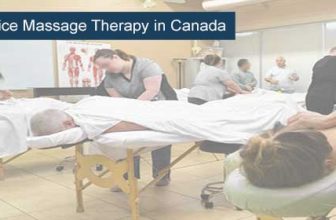
Running Tips: How to Run til you’re 100
How to be able to run until you’re 100 years old:
We have heard of Fauja Singh (born April 1, 1911), the oldest runner to finish a marathon. At 100 years old, Fauja Singh completed the Toronto Waterfront Marathon in eight hours, eleven minutes and six seconds (8:11:06). At 90 years old, he finished the London Marathon in six hours and two minutes (6:02).
A Standford University School of Medicine research headed by Dr. James Fries tracked 500 older runners for more than 20 years and proved that regular running slows the effects of aging. The study also found that elderly runners have fewer disability and longer lifespan.
You can do it too!
– Fauja did not develop the ability to walk until he was five years old. His legs were thin and weak, and he could hardly walk long distances.
– When he was young, Fauja was an amateur runner but had to give up running and return to farming do to the India-Pakistan Partition
It’s never too late!
– Fauja started running again after immigrating to England in the 90s.
– When Fauja Singh was 89 years old, he began to take running seriously and joined international marathon events.
– Fauja ran his first race in 2000 ( London Marathon) at age 89.
Fauja Singh’s Running Tips:
- He attributes his physical fitness and longevity to abstaining from smoking and alcohol and to following a simple vegetarian diet.
- He has been quoted as saying “I am very careful about different foods. My diet is simple phulka, dal, green vegetables, yogurt and milk.
- I do not touch parathas, pakoras, rice or any other fried food.
- I take lots of water and tea with ginger.
- I go to bed early taking the name of my Rabba (God) as I don’t want all those negative thoughts crossing my mind.”
- Speaking about the marathon, he said: “The first 20 miles are not difficult. As for last six miles, I run while talking to God.”
Tips on How to Run until you are 100:
1. Body Warm up then Stretching — Stretching prepares your body for activity. It reduces the risk of muscle injury, maintains mobility and flexibility, improves performance, reduces muscle tension and promotes circulation. Also stretch to cool down after running.
2. Muscle Strengthening — for your body to work and run at optimum levels, your muscles need to have balanced contractions to have proper joint control. When the muscles in our bodies are balanced, we prevent injury such as arthritis, muscle sprain and strain and imbalances. For example, strong and developed quads and ITB but weak glutes causes knee pain and injury.
3. Injuries – Acute Injury: practice R.I.C.E. – Rest Ice Compress Elevate. If possible, go to a physiotherapist and a massage therapist for rehabilitation to avoid further injury.
4. Eat healthy. Eat a balanced diet. Avoid junk food.
S.M.A.R.T. Tips given by the Canadian Physiotherapy Association (CPA) to help you get the most enjoyment out of your running program:
( https://bourassarehab.com/-login/resources/smart-running.pdf )
Stretching Tips: When stretching, physiotherapists recommend that you:
– Warm up by walking for at least five minutes
– Do slow, controlled movements to the point where you feel a mild tension in the muscle. If this pull lessens, stretch a little more – it should never be painful
– Hold the position for 20 — 30 seconds, and don’t ‘bounce’
– Breathe regularly throughout the stretch
– Repeat the stretch on the opposite side, 3 -5 times
Running Tips: Runners should concentrate on stretching the calf (gastrocnemius, soleus), thigh (quadriceps, hamstrings), groin (adductors), buttocks (gluteals), hip flexors (rectus femoris, psoas and tensor fascia lata), the iliotibial band (outside of thigh) and back.
Calves, Hamstrings and Quads Stretching:
Buttocks/ Glutes and Hip Flexors Stretching
Adductors/ Groin and ITB Stretching:
Cool down
When your run is over, take time for a cool down —a brief, relaxed walk along with some of the same stretches you did before your run. Spend at least 10 minutes cooling down to help work the metabolic wastes and excess fluid out of your muscles, and to allow your heart rate to slow down gradually. By the time you stop, your pulse should be within 20 beats-per-minute of your resting heart rate.
Running Tips: Lower Body Muscles Strengthening for Runners:
1. Glutes / Buttocks Strengthening Exercises:
2. Core/ Abs/ Adductor and Abductor Strengthening Exercises:
3. Lower Leg Strengthening Exercises:






